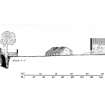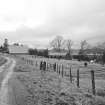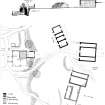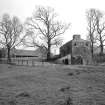Bonawe Ironworks, Ore-shed
Storehouse (18th Century) (1753)
Site Name Bonawe Ironworks, Ore-shed
Classification Storehouse (18th Century) (1753)
Alternative Name(s) Lorne Furnace Ancillary Buildings; Brochroy
Canmore ID 23524
Site Number NN03SW 5.03
NGR NN 01010 31846
Datum OSGB36 - NGR
Permalink http://canmore.org.uk/site/23524
- Council Argyll And Bute
- Parish Glenorchy And Inishail (Argyll And Bute)
- Former Region Strathclyde
- Former District Argyll And Bute
- Former County Argyll
NN03SW 5.03 01010 31846
This site has only been partially upgraded for SCRAN. Please consult the Architecture Catalogues for Argyll District for further information.
January 1998
Measured Survey (1962 - 1973)
A series of measured surveys were undertaken by RCAHMS at Lorn Furnace, Bonawe, between 1962 and 1973. In each case, an original pencil drawing was redrawn in ink and the resulting illustration was published at a reduced scale. The final set of illustrations published in 1975 (RCAHMS 1975, figs 236-247) included:
Fig. 236: Site-plan
Fig. 237: General plan of furnace
Fig. 238: Upper plan of furnace
Fig. 239: Elevation and section of furnace
Fig. 240: Elevation of E charcoal shed
Fig. 241: Plan and section of furnace, ore-shed and charcoal-sheds
Fig. 242: Roof-details and section of E charcoal-shed
Fig. 243: Roof-details and section of W charcoal-sheds
Fig. 244: Ground and first floor plans of NE workers' dwellings
Fig. 245: Ground and first floor plans of SE workers' dwellings
Fig. 246: Elevation of SE worker's dwellings
Fig. 247: Ground and first floor plans of Bonawe House
Field Visit (September 1971)
This building (Fig. 241, PI. II4A) measures 22'7 m from NE to SW by 9'1 m transversely over walls about 1'0 m in thickness. As first built, in or about 1753, however, it had a length of only 15'4 m, the NE portion having been added to the original structure at some later date. The masonry of the original building is of light grey granite, and free use is made of through-stones: the lower portions of the walls incorporate offset-courses. The masonry of the NE addition, on the other hand, is composed primarily of reddish-brown porphyrite, although a number of light-grey granite quoins have been employed. The roof is of collar-and-tie-beam truss construction, the slates being nailed to battens; the ridge piece is of stone.
In the original arrangement the building contained three storage-bays of unequal size, each provided with a high-level loading-door in the SE wall and a low-level unloading-door in the opposite wall, which faces the furnace. Similar access-arrangements are found in the NE addition, which incorporates a single large storage bay. Some time after the erection of the NE addition an open gallery, supported on timber posts, was constructed along the greater part of the NW wall to permit unloading to take place under cover. At the same time the wallhead was raised to accommodate the gallery. The floors of the storage-bays appear to have been cobbled. Most of the internal wall-surfaces are deeply stained with haematite. The structure was repaired, partly re-roofed and re-slated by the (then) Ministry of Public Building and Works in 1967-8, the timber posts of the gallery being renewed at that time.
RCAHMS 1975, visited September 1971
Publication Account (1986)
Bonawe Ironworks, situated close to the s shore of Loch Etive by Taynuilt village, is one of the most extensive and best-preserved relics of the early iron industry in Britain. It was established in 1752-3 by Richard Ford and Company as an offshoot of their works in Furness, and leases of the site and wood rights were agreed with the above-mentioned Sir Duncan Campbell and the 3rd Earl of Breadalbane for a period of 110 years. Haematite ore was brought in by sea from Lancashire and Cumberland, and a rotational system of coppicing was developed for the manufacture of charcoal, charcoal-burning stances being found in many of the natural woodlands around this part of Argyll.9 After expiry of the original lease in 1863, a new agreement was negotiated with Alexander Kelly of Bonawe, but the furnace finally closed in 1874.
As well as the furnace and storage sheds, the company erected a manager's house, workers' dwellings, and numerous ancillary buildings, which included a school, a church, a jetty and a truck-store, creating in effect a self-contained industrial community.
At the heart of the complex are the manufactory buildings, all of which occupy bankside positions on the sloping site, thus utilising the changes in level to assist what was essentially a gravity-feed process. They are solidly built of lime-mortared random or coursed rubble masonry, chiefly of the local granite, but numerous features betray their Lake District origins.
The charcoal sheds, or coal-houses, are spacious, well ventilated barn-like structures covered with open timber roofs of tie-beam construction carried down over the side-ranges as catslides. Loading-doors were situated in the rear walls, and unloading-doors, at the lower ground-level, at the front, whence the charcoal was barrowed or carried to the charging-house. The iron-ore shed, lying along the contours just NE of the charcoal sheds, was designed to be filled and emptied in a similar manner once the shipments of iron-ore had been carted up the hill from the jetty.
The blast-furnace is typical of the kind used during the later charcoal phase of the industry in Britain. The furnace openings have cast-iron lintels inscribed Bunaw. F. 1753. Apart from considerations of stability, the size and shape of the furnace were determined by the need for an adequate insulating core to reduce heat-loss and by the shaft within, whose design had to ensure a good draught and likewise prevent the friable charcoal from being crushed by an overweight of iron-ore.
The blowing-house, casting-house, store and smithy enclosing the furnace on its Nand w sides are now ruinous, but the pitched roofs formerly covering these important ancillary structures can be traced by the socket-holes in the furnace walls for the roof-timbers-roofs, incidentally, which would have given an entirely different outward appearance to the furnace compared with today. Excavations have revealed the granite base-blocks of a blowing engine introduced at some time in the 19th century to replace the original leather bellows. Both types were powered through a camshaft worked by a low breast-shot water-wheel mounted in a pit and wheel-house along the E side. The floor of the casting-house was found to be divided by a stone kerb into a part-metalled area to the N and a bed of fine sand to the s.
The rear s wall is insulated from the earth bank and retaining wall by a narrow V-shaped cavity, which has a stone conduit running along its base and that of the casting-house-presumably for collecting seepage. At the upper level, the charging house and furnace were connected across the cavity by means of a joisted timber bridge (hence the alternative name bridgehouse), and by relieving arches on the side-wall. Directly beneath the bridge a long narrow chamber, carried on a joisted floor, was contrived within the cavity. Approached from the E by an external ramp, it probably served as a bothy for the furnace-keeper during the smelting operations, and possessed the amenity of a window and a fireplace set in the retaining wall, with horizontal flues issuing from the side-walls.
The principal manufactory buildings have been described approximately in the sequence in which they occur in the smelting process. Prior to this, the three ingredients-iron ore, charcoal and limestone-underwent certain pre-treatment. Thus, the ore was washed, roasted and crushed to reduce its sulphur content and other impurities. The limestone was also broken down, and adequate stocks of charcoal had to be prepared, customarily supplied to the warehouses in 1 ½ cwt. (76 kg) bags and stacked there in dozens. It was also normal practice to pre-heat or season the furnace about a week in advance; the hearth area had to be relined where necessary and the apertures forming the tuyere and the tap-hole then sealed.
At the commencement of the smelting-operations the raw materials were assembled in the charging-house and measured in the correct proportions—the ore and limestone by weight, and the charcoal by volume—after which they were carried over the bridge and fed into the furnace shaft to its full height. Once the furnace was put into blast, the campaign (to use the trade term) was continuous, with recharging taking place constantly over a period lasting from about late autumn until early summer. Aided by a limestone flux for removing non-metallic impurities, the charge was heated and reduced to molten metal as it moved down the structure towards the hearth, a temperature of up to 1200°C being achieved by an upward blast of air supplied from two sets of bellows blowing alternately. Periodically liquid iron was run off through the tap-hole into a principal furrow formed in a bed of sand, called the sow, and its lesser branches the pigs (hence the term pig-iron). The slag (impurities and unreduced ore), being lighter than the molten iron, was drawn off last over the slag-dam. It has been estimated that the furnace was capable of producing about two tons of pig-iron per day, which, owing to its high carbon content, was hard and brittle and normally required further refining. For this purpose, apart from some casting and forging on a small scale, it was the policy at Bonawe to ship the rough bars of pig back to commercial plants in England.
Water for the ironworks was led from the River Awe about 1 mile (1.6 km) to the east by means of an aqueduct, turning at right angles at the furnace to drive the water-wheel. Supplementary supplies were held in two reservoirs situated on the high ground near the manager's house and adjacent to the upper terrace of workers' dwellings.
RCAHMS 1986, visited 1960-75






































